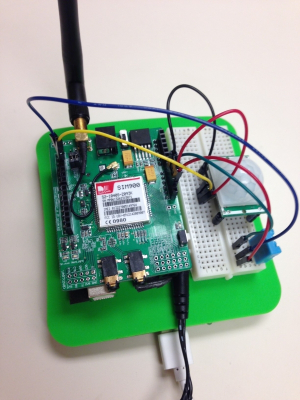Rocco De Grazia graduated in 2004 with a B.S.in electrical engineering from the University of Houston Cullen College of Engineering. Now, 10 years later,he’s still making waves in the tech community. Earlier this year, he earned a second place prize at the City of Houston’s Hackathon, a 24-hour competition celebrating the technologies and innovations that benefits society .
The Hackathon is a competition held by the City of Houston where participants have only one full day to both begin and complete a technological innovation with an aim to better society. Most participants, De Grazia said, worked on software applications – he was one of the few participants working with actual hardware.
De Grazia’s winning entry at the Hackathon was CarEye, a small solar-powered device that scans automobiles for the presence of humans in high-temperature conditions and alerts the vehicle owner by phone if a human presence is detected in the car. While a current average of 40 babies die annually from being left inadvertently in hot cars, the introduction of CarEye could virtually eradicate the issue completely.
While the Hackathon competition was held at the end of May, De Grazia said he came up with the idea for CarEye last winter. “I was reading the Houston Chronicle, and it must have been at the beginning of the year, because it was actually cold outside. I read about a lady that unfortunately forgot her child in the car, and it was because of distraction, not because she was a bad parent or anything like that,” he said. “I remember being on the phone with my wife while I was skimming the newspaper and I told her there is no way there’s nothing on the market that fixes this problem. It’s a very basic problem, why isn’t there anything on the market?”
When a colleague mentioned the Hackathon to De Grazia months later, he remembered the article and entered the competition with his idea for a solution. De Grazia works full time as a Consultant at Wipro Technologies, but spends his off time dabbling in the “Internet of things,” a concept that promotes attaching internet capabilities to everyday items in ways that improve their functionality. He approached the Hackathon with the mindset that he would set aside the 24 hours to focus solely on CarEye without the distractions of his other innovations, not realizing how well received his final product would be.
Since winning second place in the Hackathon (which included a meeting with Houston Mayor Annise Parker to pitch his idea), De Grazia said he and his business partner are working on new CarEye prototypes to present to investors. The initial device was completely constructed during the 24-hour competition, but he hopes that new prototypes will be smaller and more powerful, with different notification options like alerting local authorities if the vehicle owner doesn’t respond to the notification.
Recent news out of Atlanta of a child dying in a hot car under mysterious circumstances seems to have also brought some attention to the issue. “There have been so many cases, that’s just one of them. Lately, I’ve seen it more and more. [The Atlanta] case brought the problem to the surface,” De Grazia said.
While he doesn’t have children himself, De Grazia has become passionate about the CarEye initiative and the lives it could save. “A solution has to [become mainstream]. Whether it’s CarEye or whether it’s another company, or the government imposing a mandate to car manufacturers to implement the technology to outfit cars. It’s easily solveable, and it doesn’t make any sense not to solve [the problem]. So far this year [in the U.S.], 17 kids have died, and summer has barely started. Those are lives that could be saved. And for every one of those kids, estimates are that there are between eight and 20 close calls,” he said, adding that the number of annual hot car deaths are too small right now for car manufacturers to take notice and spend millions on research and development, but as the issue gains traction in the news, more people are petitioning the government to step in.
For Da Grazia, the solution is as simple as a CarEye device pioneered in only 24 hours, and its implementation can save around 40 children a year. “It’s too simple of a problem not to solve, and why not solve it?”
